View in other NatureServe Network Field Guides
NatureServe
Montana
Utah
Wyoming
Idaho
Wisconsin
British Columbia
South Carolina
Yukon
California
New York
Curly-leaf Pondweed - Potamogeton crispus
Other Names:
Curlyleaf Pondweed, Curly-leaved Pondweed, Curly Pondweed, Curly Leaf Pondweed
State Rank Reason (see State Rank above)
Curly-leaf Pondweed was first collected in Montana at Ninepipe Reservoir, Lake County in 1973, and was listed as a noxious weed in Montana in 2010. A conservation status rank is not applicable (SNA) because exotic plants are not a suitable target for conservation activities.
General Description
PLANTS: Aquatic perennials that produce turions (starch-containing stem buds), terminal on a stem or in leaf axils. Stems are flat and alternately branched. Sources: Parkinson et al. 2016; Lesica 2012; Haynes and Hellquist in Flora of North America (FNA) 2000).
LEAVES: All leaves are submersed; true-floating leaves are absent. Leaves are alternately arranged, fairly stiff, and range in color from red-brown to olive-green. Leaves are linear-oblong (3–8 cm × 4–10 mm) with serrate, wavy margins and a sessile, clasping base. Leaf tips are rounded. Stipules are 3–7 mm long and shred early. Sources: Parkinson et al. 2016; Lesica 2012; Haynes and Hellquist in Flora of North America (FNA) 2000).
INFLORESCENCE: Emersed spikes of 1–2 cm long, continuous, and composed of inconspicuous flowers (Lesica 2012, Parkinson et al. 2016).
Phenology
Inflorescence develops in early summer. Turions germinate in fall, grow shoots and roots in late winter to early spring, and go dormant in mid-summer to fall.
Diagnostic Characteristics
For positive species identification, all members of Potamogeton should be collected in fruit. Montana has more than 20 species of pondweeds, and users of this field guide are encouraged to identify specimens using the Manual of Montana Vascular Plants (Lesica 2012).
The combination of slightly flattened stems and submersed leaves with wavy margins (resembling a lasagna noodle) that are also minutely toothed and clasp the stem distinguishes Curly-leaf Pondweed. Young leaves may lack wavy margins. Leaf shape is also linear to oblong. Turions are present in fall and winter (DiTomaso and Healy 2003).
Richardson’s Pondweed (
Potamogeton richardsonii) also has alternately arranged leaves that clasp the stem and have wavy leaf margins, but margins lack teeth (entire), leaf tips are pointed, and leaf shape is lanceolate to ovate (Parkinson et al. 2016). The stems are round with little branching.
White-stemmed Pondweed (
Potamogeton praelongus) also has alternately arranged leaves that clasp the stem and have minutely wavy leaf margins, but margins lack teeth (entire), leaf tips are pointed, and some leaves are greater than 10cm long (Parkinson et al. 2016). The stems are round and zig-zag, and there is little branching.
Species Range
Montana Range
Range Descriptions
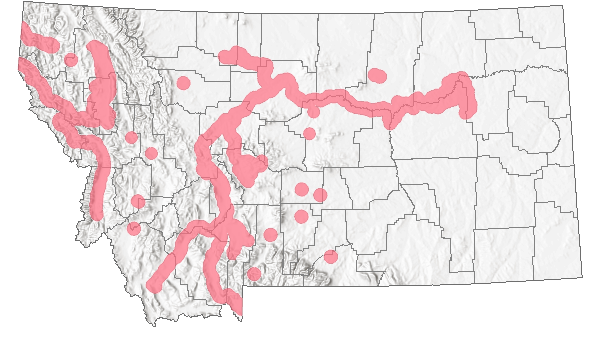
 Non-native
Non-native
Range Comments
Curly-leaf Pondweed is native to Europe, and introduced through most of North America (Lesica 2012). In North America the first documented specimen was found near Philadelphia about 1840, and populations were confined to the northeast prior to the 1900s (FNA 2000; Parkinson et al. 2016). By 1950 it had spread to most of the continental U.S (Parkinson et al. 2016). In Montana it was first reported in Lake County in 1973 (Parkinson et al. 2016).
For maps and other distributional information on non-native species see:
Nonindigenous Aquatic Species Database from the U.S. Geological Survey
Invasive Species Habitat Tool (INHABIT) from the U.S. Geological Survey
Invasive Species Compendium from the Centre for Agriculture and Bioscience International (CABI)
EDDMapS Species Information EDDMapS Species Information
Observations in Montana Natural Heritage Program Database
Number of Observations: 3901
(Click on the following maps and charts to see full sized version)
Map Help and Descriptions
Relative Density
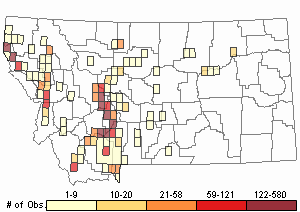
Recency
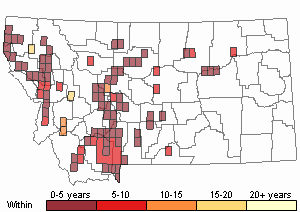
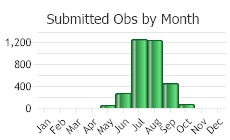
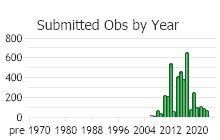
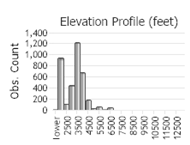 (Observations spanning multiple months or years are excluded from time charts)
(Observations spanning multiple months or years are excluded from time charts)
Habitat
Shallow to deep (18 feet), fresh or saline water of ponds, lakes, and slow streams in the plains and valleys (Lesica 2012; Parkinson et al. 2016). It can tolerate a moderate current (Parkinson et al. 2016). It is typically found at depths from 3.2 to 10 feet. It grows best in alkaline, calcareous water (Parkinson et al. 2016). Substrates range from sandy to hard bottoms; it grows best on substrates that contain 10-25% organic matter and are not too coarse or too fine (Parkinson et al. 2016).
Ecology
The ability of turions to initiate growth earlier than native plants gives Curly-leaf Pondweed a competitive advantage (Parkinson et al. 2016). Further, it avoids competition during mid-summer when turions become dormant while native aquatic plants are actively growing. Turions break their dormancy in fall to germinate, which is when native aquatic plants are becoming dormant.
Dispersal occurs primarily by plant fragments that contain turions, and less frequently by seeds (DiTomaso and Healy 2003; Parkinson et al. 2016). Seeds float and disperse with water through ingestion or clinging to the feet, fur, or feathers of animals (DiTomaso and Healy 2003). In Minnesota, production ranged from 725 to 2,713 turions per square meter (Woolf and Madsen 2003). In South Africa, a study found that less than 0.1% of seeds germinated (Rogers and Breen 1980).
All pondweed species contribute to the food chain and provide habitat for aquatic animals (DiTomaso and Healy 2003). As an exotic plant, Curly-leaf Pondweed lacks controls that can limit its population. The early spring growth of Curly-leaf Pondweed shades-out and inhibits native aquatic plants (Parkinson et al. 2016). This growth can result in dense mats that inhibit boating and swimming. Some studies have shown that native aquatic plants cannot recover, even though Curly-leaf Pondweed dies-back (becomes dormant) in mid-summer. Abundant growth impedes water flow in irrigation canals, potentially impacting agricultural production. Abundant growth also depletes nutrients, which are problematic for commercial fisheries. The mid-summer dieback and decay of Curly-leaf Pondweed depletes oxygen in the water, potentially encouraging algal blooms.
Reproductive Characteristics
The flowering spike (inflorescence) grows above the water and is unbranched, erect to ascending, and usually terminal (2.5-4 cm long and 10-15 mm wide) (Parkinson et al. 2016). Tepals are yellowish and about 1 mm long. Fruits are red to red-brown, obovoid (egg-shaped), and with a beak that is recurved 2-3 mm at its tip (FNA 2000).
Turions resemble brown pine cones of 7-25(50) mm long with reduced leaves that are broad and hardened at their bases (DiTomaso and Healy 2003).
LIFE CYCLE (adapted from Parkinson et al. 2016)
The life cycle of Curly-leaf Pondweed is different from that of other pondweed species. Turions germinate in the fall and overwinter under ice. In spring when the water temperatures rise to 41 degrees Fahrenheit (5 degrees Celsius), the turions develop shoots and roots. In early summer, the inflorescence develops and emerges above the water’s surface. Flower development and turion growth coincide and is optimal at temperatures above 59 degrees Fahrenheit with increasing day lengths. When fully developed turions sink to the floor of the water body, the existing foliage begins to decay, and dormancy begins. Dormancy is broken by decreasing daylight and temperatures less than 68 degrees Fahrenheit.
Management
Curly-leaf Pondweed has been a listed noxious weed in Montana since 2010. Its spread from one water body to another has primarily occurred through plant fragments containing turions that are on boat trailers and recreational equipment (Parkinson et al. 2016).
PREVENTION (adapted from Parkinson et al. 2016)
* Thoroughly rinse any mud and debris from all equipment and wading gear, and drain the water from the boat before leaving access areas. Use boat-washing stations when available.
* Remove all plant fragments from the boat, propeller, and boat trailer.
* Dry boats and equipment for 5 days before transporting them to a new water body.
* Do not dispose aquarium water or plants into water bodies.
* Desiccate plant material and/or dispose by securely sealing in plastic bags and placing in the trash for disposal.
* Learn to identify Curly-leaf Pondweed and report your findings to the Montana Department of Agriculture; Montana Fish, Wildlife and Parks; County Extension agent; or Weed Coordinator.
CHEMICAL CONTROL (adapted from Parkinson et al. 2016)
Diquat (Resard, Weedtrine-D), Endothall (Aquathol, Hydrothol 191), and Fluridone (Sonar A.S, Sonar SRP) have been used to herbicide plants in water bodies. The timing of chemical control, water temperature, and herbicide concentration, and other factors are critical to effectively hinder Curly-leaf Pondweed and reduce negative impacts to native vegetation – see Parkinson et al. 2016, and always follow chemical label instructions and use restrictions. These herbicides must be applied by applicators with an Aquatic Pest Control license. Consult your County Extension Agent and/or Weed District for more information on herbicidal control of Curly-leaf Pondweed. Curly-leaf Pondweed initiates growth prior to the native plants, which can help reduce negative impacts from herbicides on native vegetation. However water temperatures must still be appropriate for the herbicide to work on Curly-leaf Pondweed.
MECHNICAL CONTROL (adapted from Parkinson et al. 2016)
Raking and hand-cutting can be effective for controlling smaller populations of Curly-leaf Pondweed. All plant material should be bagged and desiccated before placing in the trash for disposal. Raking and hand-cutting should be done in spring to early summer to prevent the formation of turions, which will disrupt its life cycle. These methods need to be repeated for many years, and monitored thereafter to ensure the plant does not re-establish. See Parkinson et al. 2016 for further details.
PHYSICAL CONTROL (adapted from Parkinson et al. 2016)
Benthic barriers are mats that are laid down on the floor of the water body around docks and other high-use areas. They prevent light from penetrating and prevent plants from rooting. They are usually effective, but kill all vegetation and are long-lasting.
Drawdowns that lower the water levels in the fall can be effective, but requires extensive planning and permitting, and can hurt non-targeted vegetation and animal life.
Dredging excavates the floor of the water body. This deepens the water body to prevent light penetration. This control can be effective, but requires extensive planning and permitting, and can hurt non-targeted vegetation and animal life.
BIOLOGICAL CONTROL (adapted from Parkinson et al. 2016)
Grass carp have been used in portions of the United States to control Curly-leaf Pondweed. However, these fish feed on other aquatic plants and destroy habitat. They are not legally allowed in Montana.
CULTURAL CONTROL (adapted from Parkinson et al. 2010)
To avoid accidentally introducing non-native plants to surrounding water bodies, never place your water-garden near or allow water to overflow into wetlands, streams, rivers, lakes, or ponds. Non-native water-garden plants should never be dumped into natural water bodies. Before purchasing plants, verify that the plant is not invasive.
Contact information for Aquatic Invasive Species personnel:Montana Fish, Wildlife, and Parks Aquatic Invasive Species staffMontana Department of Natural Resources and Conservation's Aquatic Invasive Species Grant ProgramMontana Invasive Species Council (MISC)Upper Columbia Conservation Commission (UC3)Stewardship Responsibility
References
- Literature Cited AboveLegend:
 View Online Publication
View Online Publication Lesica, P., M.T. Lavin, and P.F. Stickney. 2012. Manual of Montana Vascular Plants. Fort Worth, TX: BRIT Press. viii + 771 p.
Lesica, P., M.T. Lavin, and P.F. Stickney. 2012. Manual of Montana Vascular Plants. Fort Worth, TX: BRIT Press. viii + 771 p.
- Additional ReferencesLegend:
 View Online Publication
View Online Publication
Do you know of a citation we're missing? DiTomaso, J.M. and E.A. Healy. 2003. Aquatic and riparian weeds of the West. Regents of University of California, Division of Agriculture and Natural Resources, Publication 3421.
DiTomaso, J.M. and E.A. Healy. 2003. Aquatic and riparian weeds of the West. Regents of University of California, Division of Agriculture and Natural Resources, Publication 3421. Flora of North America Editorial Committee (FNA). 2000. Flora of North America north of Mexico. Vol. 22. Magnoliophyta: Alismatidae, Arecidae, Commelinidae (in part), and Zingiberidae. Oxford Univ. Press, New York. xxiii + 352 pp.
Flora of North America Editorial Committee (FNA). 2000. Flora of North America north of Mexico. Vol. 22. Magnoliophyta: Alismatidae, Arecidae, Commelinidae (in part), and Zingiberidae. Oxford Univ. Press, New York. xxiii + 352 pp. Jeanes, E.D. 1996. Behavioral responses to water current of age-0 Arctic Grayling from the Madison River, and their use of stream habitat. M.Sc. Thesis. Bozeman, MT: Montana State University. 60p.
Jeanes, E.D. 1996. Behavioral responses to water current of age-0 Arctic Grayling from the Madison River, and their use of stream habitat. M.Sc. Thesis. Bozeman, MT: Montana State University. 60p. Larson, G. E. 1993. Aquatic and wetland vascular plants of the northern Great Plains. USDA Forest Service General Technical Report RM-238. Rocky Mountain Forest and Range Experiment Station, Fort Collins, CO. 681 pp.
Larson, G. E. 1993. Aquatic and wetland vascular plants of the northern Great Plains. USDA Forest Service General Technical Report RM-238. Rocky Mountain Forest and Range Experiment Station, Fort Collins, CO. 681 pp. Lesica, P., M.T. Lavin, and P.F. Stickney. 2022. Manual of Montana Vascular Plants, Second Edition. Fort Worth, TX: BRIT Press. viii + 779 p.
Lesica, P., M.T. Lavin, and P.F. Stickney. 2022. Manual of Montana Vascular Plants, Second Edition. Fort Worth, TX: BRIT Press. viii + 779 p. Montana Department of Agriculture (MDA). 2017. Montana Noxious Weed List. February. Helena, Montana.
Montana Department of Agriculture (MDA). 2017. Montana Noxious Weed List. February. Helena, Montana. Parkinson, H., J. Mangold, and C. McLane. 2016. Biology, ecology and management of Curlyleaf Pondweed (Potamogeton crispus). EB0223. July. Montana State University Extension, Bozeman, Montana.
Parkinson, H., J. Mangold, and C. McLane. 2016. Biology, ecology and management of Curlyleaf Pondweed (Potamogeton crispus). EB0223. July. Montana State University Extension, Bozeman, Montana. Rogers, K.H. and C.M. Breen. 1980. Growth and reproduction of Potamogeton crispus in a South African lake. Journal of Ecology 68:561-571.
Rogers, K.H. and C.M. Breen. 1980. Growth and reproduction of Potamogeton crispus in a South African lake. Journal of Ecology 68:561-571.
- Web Search Engines for Articles on "Curly-leaf Pondweed"





